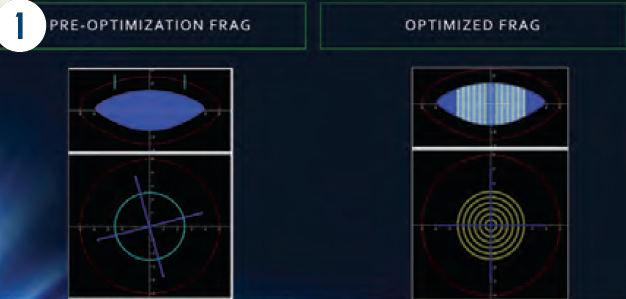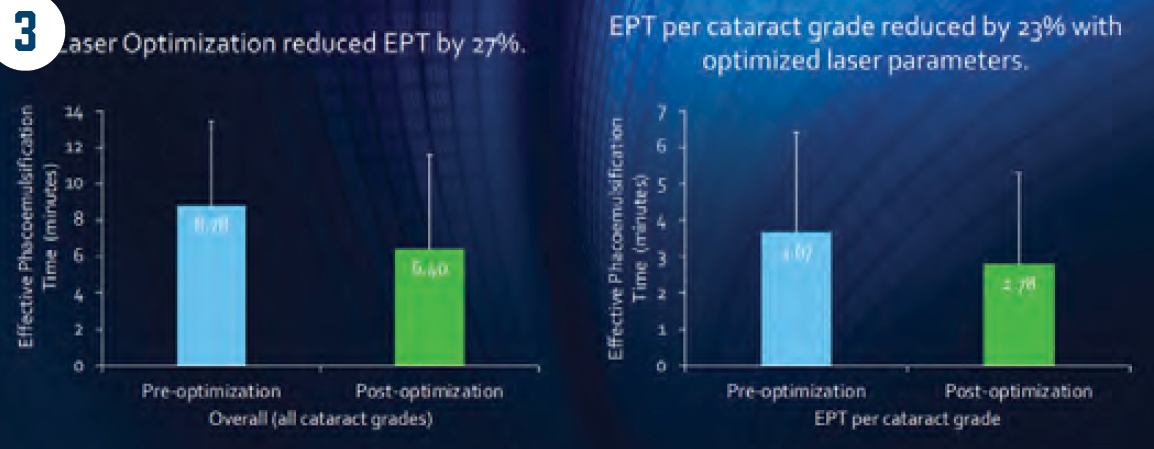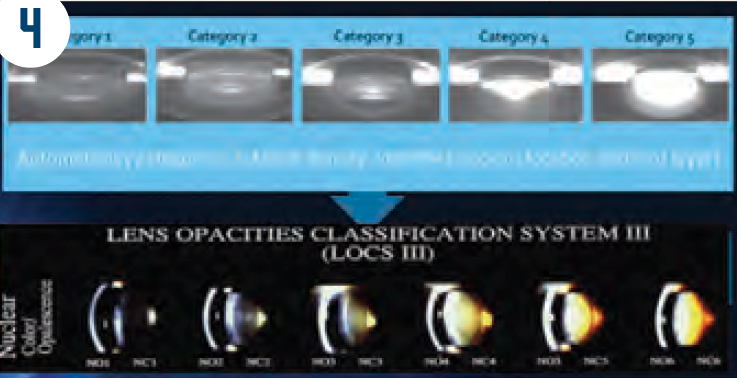Article
Pearls for optimizing femtosecond laser phacofragmentation patterns
Cataract density and the fragmentation pattern the surgeon uses may influence the amount of ultrasound energy used for phacoemulsification and EPT.
Figure 1. A cross pattern was applied to cataracts in the pre-optimization or standard phacofragmentation group, and a cross pattern was combined with concentric rings in the optimized phacofragmentation group. (Images courtesy of James D. Lehmann, MD)

By James D. Lehmann, MD
As we have known since the dawn of phacoemulsification, the quantity of ultrasound energy expended during cataract surgery correlates with the amount of postoperative corneal edema and endothelial cell loss. This leads to a slower visual recovery after surgery.
When the femtosecond laser is used to soften and fragment the nucleus before phacoemulsification, it reduces the effective phacoemulsification time (EPT) and may decrease anterior chamber inflammation, resulting in less endothelial cell loss and corneal edema.1 Cataract density and the fragmentation pattern the surgeon uses may influence the amount of ultrasound energy used for phacoemulsification and EPT.
For the last several years, we have been using the Lensar Laser System with Streamline, which optimizes phacofragmentation parameters based on automated cataract density grading. This system is equipped with advanced Scheimpflug imaging that displays the anterior and posterior lens curvatures and determines the cataract density. Based on the density of the cataract, the Lensar laser selects the optimal phacofragmentation pattern to fragment the nucleus with the goal of decreasing the EPT. This improves operating room efficiency and helps with the patient’s visual recovery.
Study results
Using the Lensar Laser System with Streamline with automated cataract density grading and customized phacofragmentation, my colleagues and I performed a multicenter observational study of cataract patients.2 Our goal was to determine whether an optimized laser phacofragmentation pattern reduced EPT compared with the standard pattern.
Patients having automated cataract density grading and femtosecond laser-assisted cataract surgery were assigned to 2 groups: standard phacofragmentation (68 patients) or optimized phacofragmentation (45 patients) based on automated cataract density grading.
In the standard group, a cross pattern was applied to the cataract, whereas in the optimized group, the cross pattern was combined with concentric rings (Figure 1).
Figure 2. Laser optimization produced better fault lines for splitting the nucleus and more cylinders to soften it. (Image courtesy of James D. Lehmann, MD)

When phacofragmentation was customized with optimized laser parameters, it produced better fault lines to split the nucleus and more cylinders to soften it (Figure 2). It was easier to break up the lens, and less energy was used. With optimized laser parameters, EPT was reduced by 27%, and EPT per cataract grade was reduced by 23% compared with settings that were not optimized (Figure 3). Surgery was completed within 10 minutes in nearly 95% of these patients.
Phacofragmentation with optimized laser parameters reduced the overall mean EPT and EPT per cataract grade compared with preoptimized phacofragmentation.

New technology
The automatic cataract density grading system is part of all Lensar systems, including the new ALLY Adaptive Cataract Treatment System, recently approved by the US Food and Drug Administration. The ALLY system, which is the first technology to combine the femtosecond laser and phacoemulsification in the same system, will optimize fragmentation even more quickly.
Automated cataract density grading vs LOCS III.

Lensar is the only company with an automated cataract density grading system to optimize fragmentation. This femtosecond laser technology has 2 major advantages that make it easier to obtain better outcomes and reduce the risk of errors. It syncs with the Pentacam (Oculus), compensating for cyclorotation and eliminating the need for manual, preoperative ink marking before implanting toric IOLs. In addition, it centers the capsulorhexis based on the pupil, optimizing centration of the IOL.
Optimizing cataract surgery
As surgeons, we tend to get comfortable with our technological tools, rarely changing parameters or using newer devices. However, I challenge everyone to invite Lensar engineers to their site to explore automated cataract density grading with customized phacofragmentation patterns to see how it can improve their processes and patient outcomes.
Many surgeons are reticent about investing in a laser and incorporating it into their surgical flow because they fear it will slow them down significantly, but with the right adjustments to the process, we can be as efficient as we would be with traditional surgery.
Transitioning from traditional cataract surgery to femtosecond laser cataract surgery is one of the best decisions we have ever made. Patients have high expectations of their visual outcomes after cataract surgery. They want to reduce their dependence on glasses, and we need to do all that we can to optimize their results. Technological advances in centration of the IOL, alignment of the toric axis, and automated cataract density grading and customized phacofragmentation with a femtosecond laser equipped with Scheimpflug imaging increase our accuracy and our confidence in delivering the results our patients expect. This leads to happier patients with better outcomes.
Conclusion
I invite all cataract surgeons using femtosecond laser-assisted surgery to reexamine the fragmentation patterns they are using and consider customizing fragmentation patterns to each eye. We believed we were delivering superior results, but when we began using this new phacofragmentation pattern, it reduced EPT and led to an even smoother surgery.
James D. Lehmann, MD
P: 210-880-3221
Lehmann practices with Focal Point Vision in San Antonio, Texas, and is adjunct faculty at UT Health San Antonio. His financial disclosures include Lensar, CorneaGen, Diamatrix, Glaukos, Johnson & Johnson, Modernizing Medicine, and RxSight.
References
1. Chen X, Yu Y, Song X, Zhu Y, Wang W, Yao K. Clinical outcomes of femtosecond laser-assisted cataract surgery versus conventional phacoemulsification surgery for hard nuclear cataracts. J Cataract Refract Surg. 2017;43(4):486-491. doi:10.1016/j.jcrs.2017.01.010
2. Lehmann J. Automated cataract density grading optimization of femtosecond laser phacofragmentation pattern to reduce phaco time, tip time and case time. Presented at: American Society of Cataract and Refractive Surgery Annual Meeting; April 22-26, 2022; Washington, DC.
Newsletter
Don’t miss out—get Ophthalmology Times updates on the latest clinical advancements and expert interviews, straight to your inbox.





